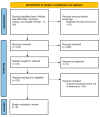CONUT Score as a Predictor of Mortality Risk in Acute and Chronic Heart Failure: A Meta-Analytic Review
- PMID: 40431475
- PMCID: PMC12114259
- DOI: 10.3390/nu17101736
CONUT Score as a Predictor of Mortality Risk in Acute and Chronic Heart Failure: A Meta-Analytic Review
Abstract
Heart failure (HF) is a major global health burden and a leading cause of morbidity and mortality. Nutritional status has emerged as an essential factor influencing outcomes in HF, with the Controlling Nutritional Status (CONUT) score gaining attention as a simple, objective marker derived from serum albumin, total cholesterol, and lymphocyte count. This meta-analysis evaluated the prognostic value of the CONUT score in predicting all-cause mortality in patients with acute and chronic heart failure. A systematic search was conducted in the PubMed, MEDLINE, Google Scholar, and Cochrane Library databases for the past ten years, using combinations of keywords such as "heart failure", "CONUT score", "malnutrition", and "mortality". Studies were included if they reported hazard ratios (HRs) for all-cause mortality in relation to CONUT score categories in adult HF populations. Eight eligible studies comprising 15,761 patients were included. Pooled analysis showed that higher CONUT scores were significantly associated with increased all-cause mortality (pooled HR = 1.47; 95% CI: 1.30-1.66). Despite substantial heterogeneity (I2 = 80%), the direction of effect was consistent across studies. The CONUT score is a useful prognostic marker in acute and chronic heart failure patients. Further research should explore the effects of targeted nutritional interventions in high-risk HF patients identified by elevated CONUT scores and efforts to standardize malnutrition cut-offs in clinical practice.
Keywords: CONUT score; heart failure; malnutrition; mortality; nutritional screening; nutritional status; risk stratification.
Conflict of interest statement
The authors declare no conflicts of interest.
Figures




References
-
- Ponikowski P., Voors A.A., Anker S.D., Bueno H., Cleland J.G.F., Coats A.J.S., Falk V., González-Juanatey J.R., Harjola V.P., Jankowska E.A., et al. 2016 ESC Guidelines for the diagnosis and treatment of acute and chronic heart failure: The Task Force for the diagnosis and treatment of acute and chronic heart failure of the European Society of Cardiology (ESC)Developed with the special contribution of the Heart Failure Association (HFA) of the ESC. Eur. Heart J. 2016;37:2129–2200. - PubMed
-
- Severino P., D’Amato A., Prosperi S., Mariani M.V., Myftari V., Labbro Francia A., Cestiè C., Tomarelli E., Manzi G., Birtolo L.I., et al. Strategy for an early simultaneous introduction of four-pillars of heart failure therapy: Results from a single center experience. Am. J. Cardiovasc. Drugs. 2024;24:663–671. doi: 10.1007/s40256-024-00660-6. - DOI - PMC - PubMed
-
- Baptista R., Silva Cardoso J., Canhão H., Maria Rodrigues A., Kislaya I., Franco F., Bernardo F., Pimenta J., Mendes L., Gonçalves S., et al. Portuguese heart failure prevalence: Observational study based on primary care records. Rev. Port. Cardiol. (Engl. Ed.) 2023;42:985–995. doi: 10.1016/j.repc.2023.10.004. - DOI - PubMed
-
- Heidenreich P.A., Bozkurt B., Aguilar D., Allen L.A., Byun J.J., Colvin M.M., Deswal A., Drazner M.H., Dunlay S.M., Evers L.R., et al. 2022 AHA/ACC/HFSA Guideline for the Management of Heart Failure: A Report of the American College of Cardiology/American Heart Association Joint Committee on Clinical Practice Guidelines. Circulation. 2022;145:e895–e1032. doi: 10.1161/CIR.0000000000001063. - DOI - PubMed
Publication types
MeSH terms
Substances
LinkOut - more resources
Full Text Sources
Medical
Research Materials
Miscellaneous

